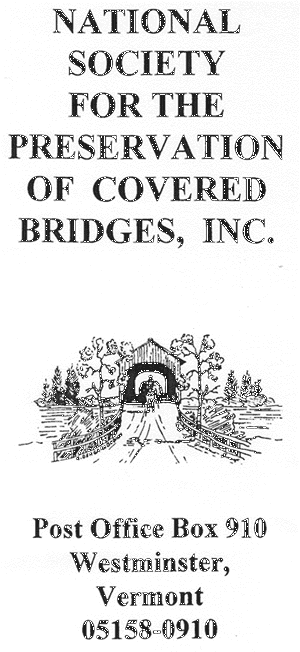whatis
Back to NSPCB First Page
This country's remaining Covered Bridges are a National Treasure! Even in their sometimes
dilapidated or poorly restored condition, these spans bear truthful witness to much that is
American Culture and Heritage, and ought thus to be preserved!
The National Society for the Preservation of Covered
Bridges, founded in 1950, has been instrumental in saving many historic spans from demolition,
perhaps even one that you may know of.
Will you therefore, dear Friend of Covered Bridges, help the
Society with its important work? Will you:
a) notify the National Society at Post Office Box 910, Westminster, Vermont 05158- 0910 should
you learn of any plans to demolish a Covered Bridge, and
b)consider joining the National Society yourself? There is, after all, much strength to be had in
numbers.
Information concerning membership in, as well as the various
activities of, the National Society is given in this brochure.
Dear Covered Bridge Enthusiast, did you know that as
recently as 1959, there were still some 1,344 authentic nineteenth and early twentieth century
Covered Wooden Bridges standing in these United States, many of them in near original
condition, but that by June 1st 1989, 492 of these had been lost to demolition, neglect, or
arson?
Today, alas, there are fewer than 1,030 Covered Wooden
Spans remaining in all of North America.
Ever since the early 1950's, we in the National Society for
the Preservation of Covered Bridges, well aware of what has been taking place out in the field,
have been diligently working to try to help preserve this country's surviving Covered Wooden
Spans. It has not always been an easy task -- it has often been a lonely combat.
In the early days of the Society, the principle difficulty to be
overcome was how to convince regional highway authorities, or selectmen, that a particular
Covered Wooden Span in perhaps fairly dilapidated condition had nevertheless intrinsic historic
value, and ought thus to be preserved, if possible, not simply demolish to be replaced by a
structure of modern design.
When such campaigns were successful -- and that sometimes
was the case -- the structures in question were usually repaired in kind, and therefore retained
much of their historic interest.
More recently, however, now that there is no longer any question but
that nineteenth and early twentieth century Covered Wooden Bridges ought to be preserved,
discussions with public officials are usually centered on methods of restoration and
preservation.
Respecting the latter, the National Society are in the forefront
of those arguing for the use of traditional materials and procedures in Covered Bridge renovation
projects. In the opinion of the Society, galvanized bolts, pressed washers, metal splice plates,
glue-laminated timbers, and the like, have no legitimate place within the confines of an ancient
Covered Wooden Span. There, such materials can only denature and adulterate, never restore or
recreate.
In any campaign to preserve a particular Covered Bridge, or
even Covered Bridges in general, good, accurate data are ofttimes invaluable. In this regard,
please note that the National Society publishes a listing of all remaining Covered Bridges in the
world, called simply, the World Guide to Covered Bridges - Should information
concerning the location, age, number of spans, and so forth, of a given structure be required, this
information will most likely be found in the pages of the above mentioned publication.
As well as the World Guide to Covered
Bridges, the
National Society also puts out a quarterly magazine called Covered Bridge Topics, and a
newsletter entitled simply, the Newsletter.
It is important to note that Topic itself was
founded in 1943 by Richard Sanders Allen, a noted Covered Bridge Authority and author of many
books and articles on the subject.
In the Allen tradition, the pages of Topics continue
to be filled with interesting historical facts and photographs, some never having seen the light of
day before in any other publication. The Newsletter keeps everyone up-to-date with what is
happening in the world of the Covered Bridge.
The National Society for the Preservation of Covered Bridges
has been determined to be a non-profit educational-charitable institution as defined in section 501
(c)(3) of the Internal Revenue Code, and consequently, all donations to the Society are tax
deductible.
Individual or family membership in the Society costs $15 per
year, and includes subscriptions to both Topics and the Newsletter.
Please help preserve these Engineering and Architectural
Masterpieces, our remaining Covered Wooden Bridges. Join the National Society today!
Joe Nelson, P.O Box 267, Jericho, VT 05465-0267, jcnelson@together.net
This web site page was coded by J.C. Nelson. The content is the intellectual property of the
National Society for the Preservation of Covered Bridges, Inc. and its membership.
This file revised 03-22-06